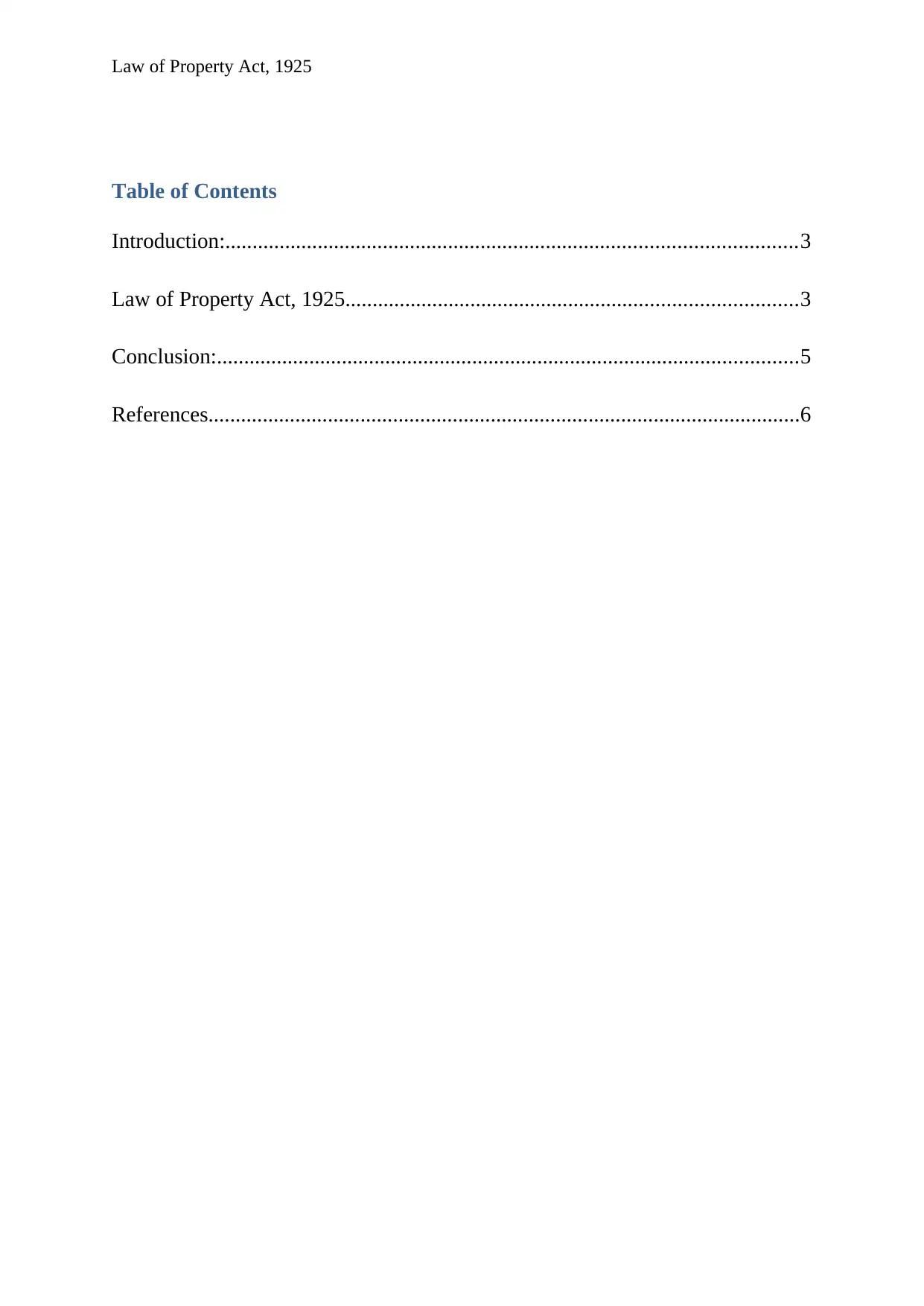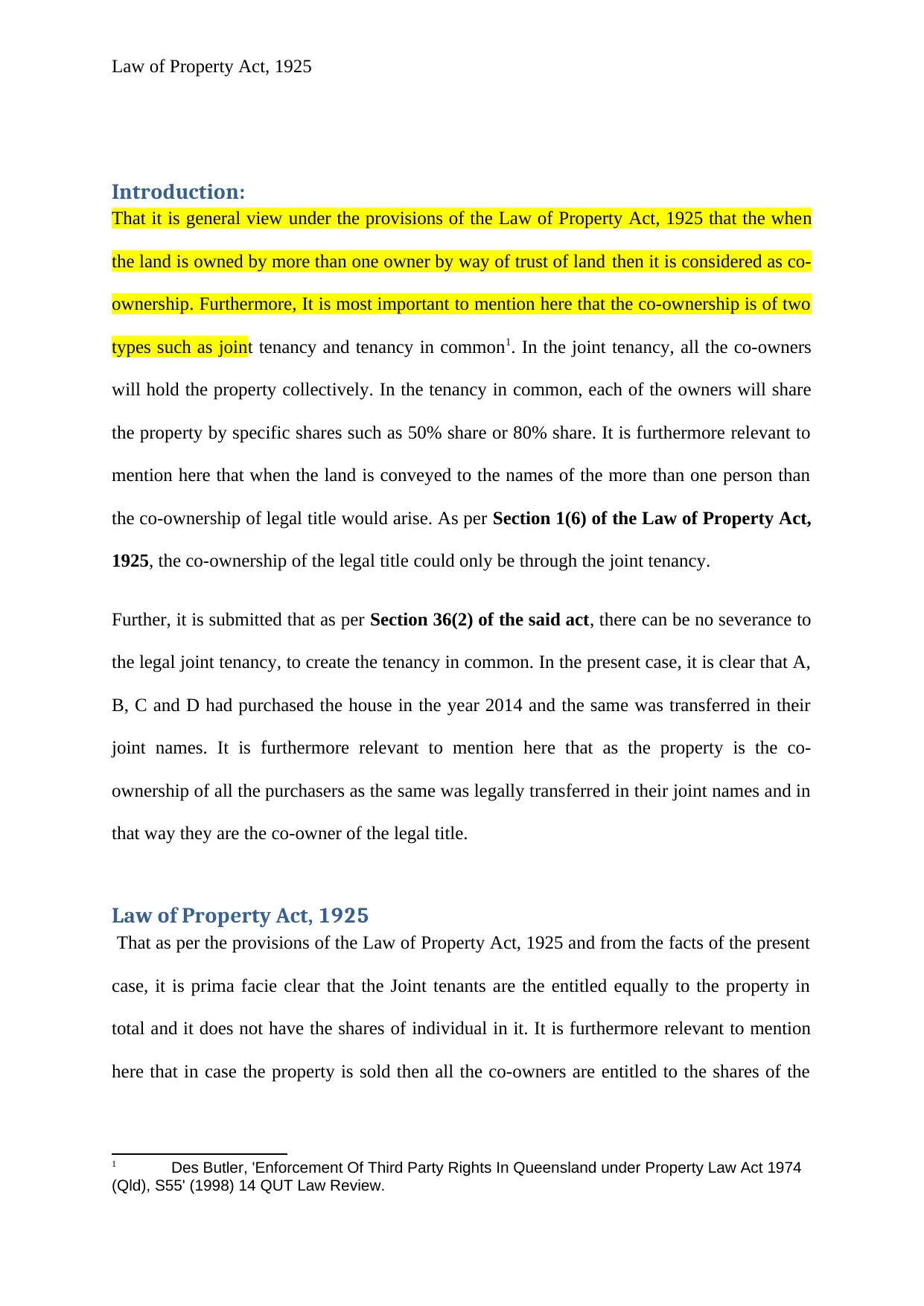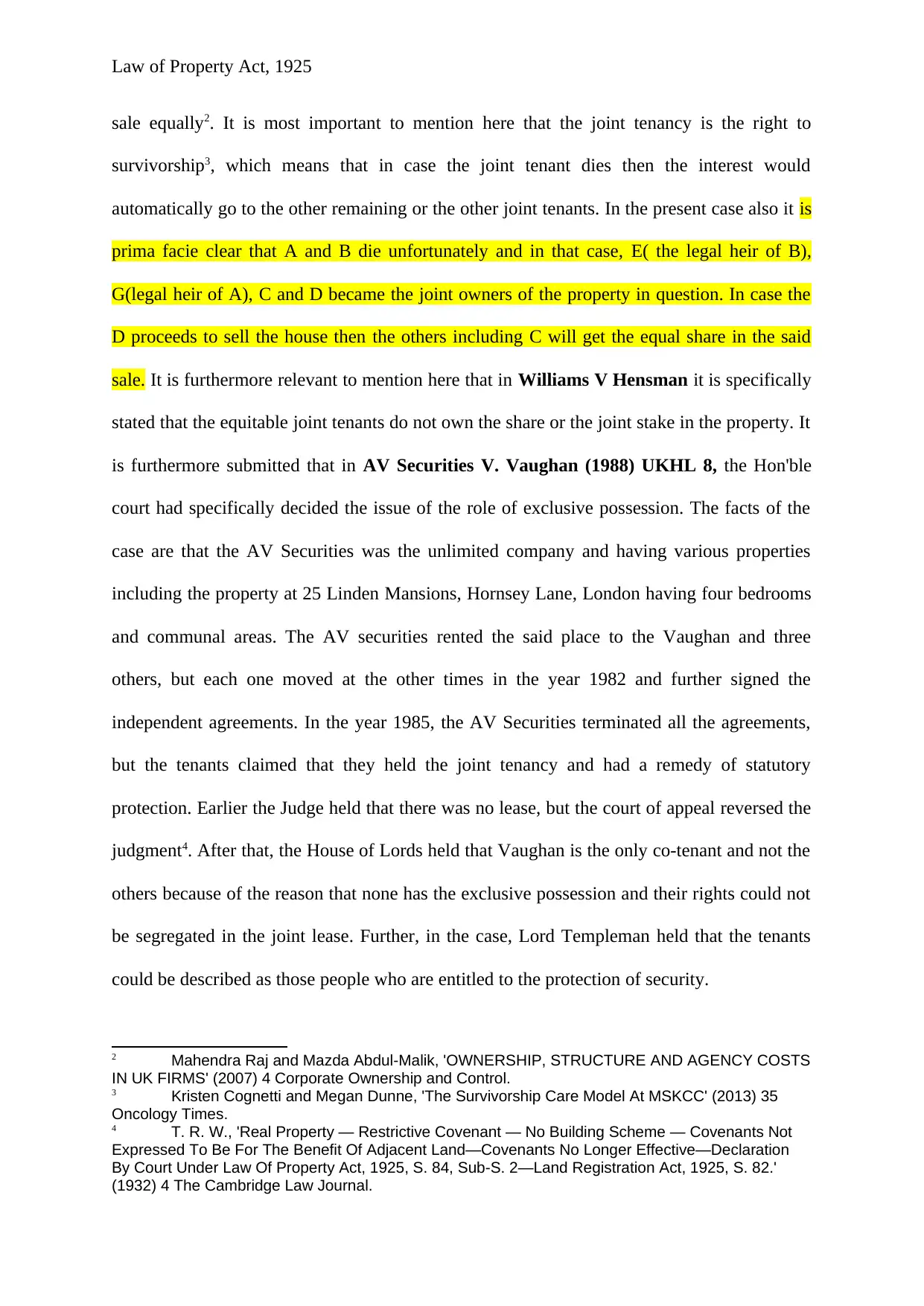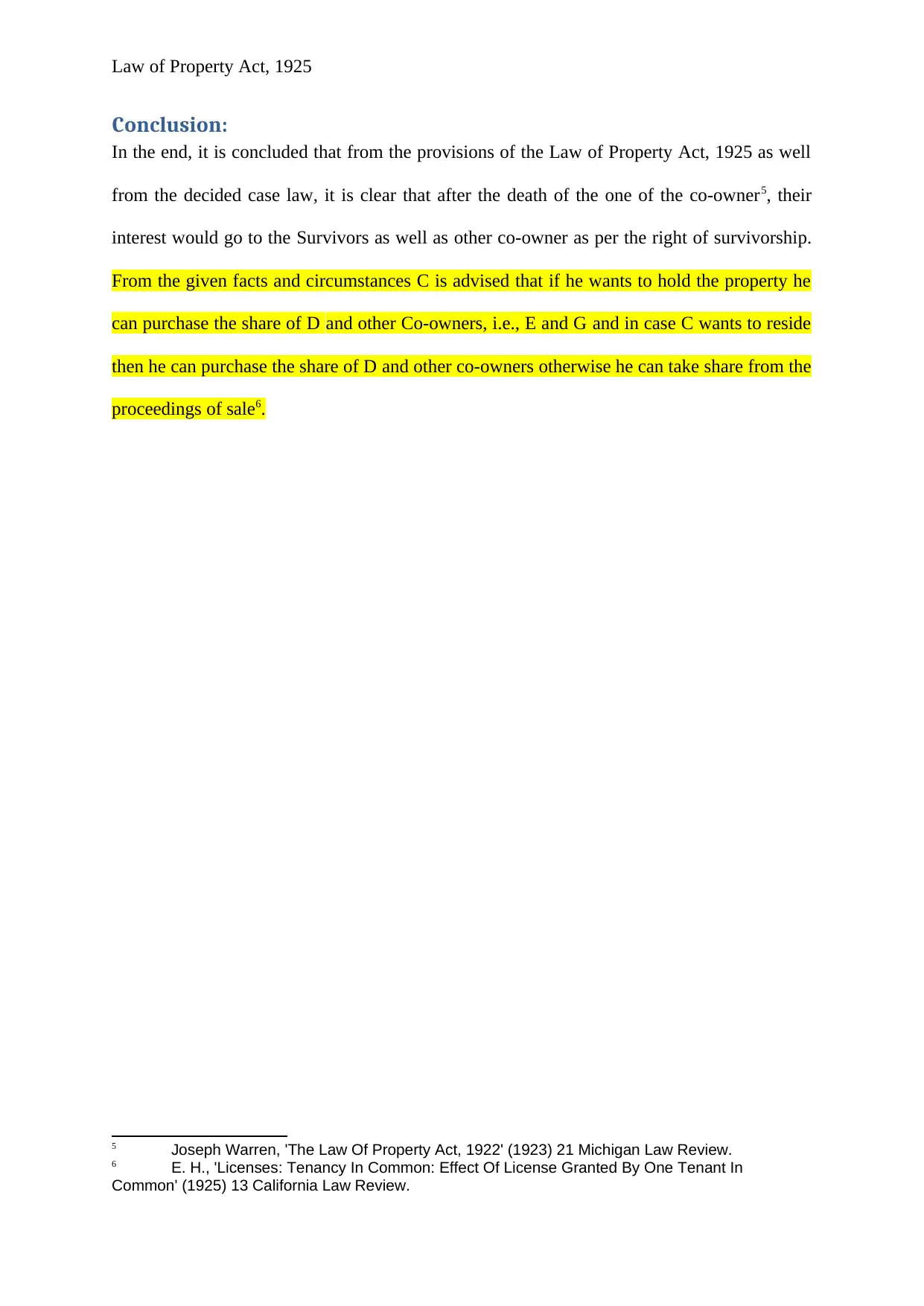Legal Analysis: Co-ownership under the Law of Property Act, 1925
VerifiedAdded on 2023/05/30
|6
|1299
|75
Report
AI Summary
This report analyzes the Law of Property Act, 1925, specifically focusing on the principles of co-ownership. It begins by defining co-ownership within the context of land ownership, distinguishing between joint tenancy and tenancy in common. The report details the characteristics of each type of co-ownership, including the right of survivorship in joint tenancy and the concept of undivided shares in tenancy in common. The report also references relevant case law, such as AV Securities V. Vaughan, to illustrate the application of these principles. The conclusion summarizes the key takeaways regarding the distribution of property interests upon the death of a co-owner and provides practical advice. The report highlights how the legal framework established by the Law of Property Act, 1925, governs the rights and responsibilities of co-owners and influences property distribution.

Running Head: Law of Property Act, 1925
Title:
Assignment Name:
Student Name
Course Name and Number:
Professor:
Date:
Title:
Assignment Name:
Student Name
Course Name and Number:
Professor:
Date:
Paraphrase This Document
Need a fresh take? Get an instant paraphrase of this document with our AI Paraphraser

Law of Property Act, 1925
Table of Contents
Introduction:.........................................................................................................3
Law of Property Act, 1925...................................................................................3
Conclusion:...........................................................................................................5
References.............................................................................................................6
Table of Contents
Introduction:.........................................................................................................3
Law of Property Act, 1925...................................................................................3
Conclusion:...........................................................................................................5
References.............................................................................................................6

Law of Property Act, 1925
Introduction:
That it is general view under the provisions of the Law of Property Act, 1925 that the when
the land is owned by more than one owner by way of trust of land then it is considered as co-
ownership. Furthermore, It is most important to mention here that the co-ownership is of two
types such as joint tenancy and tenancy in common1. In the joint tenancy, all the co-owners
will hold the property collectively. In the tenancy in common, each of the owners will share
the property by specific shares such as 50% share or 80% share. It is furthermore relevant to
mention here that when the land is conveyed to the names of the more than one person than
the co-ownership of legal title would arise. As per Section 1(6) of the Law of Property Act,
1925, the co-ownership of the legal title could only be through the joint tenancy.
Further, it is submitted that as per Section 36(2) of the said act, there can be no severance to
the legal joint tenancy, to create the tenancy in common. In the present case, it is clear that A,
B, C and D had purchased the house in the year 2014 and the same was transferred in their
joint names. It is furthermore relevant to mention here that as the property is the co-
ownership of all the purchasers as the same was legally transferred in their joint names and in
that way they are the co-owner of the legal title.
Law of Property Act, 1925
That as per the provisions of the Law of Property Act, 1925 and from the facts of the present
case, it is prima facie clear that the Joint tenants are the entitled equally to the property in
total and it does not have the shares of individual in it. It is furthermore relevant to mention
here that in case the property is sold then all the co-owners are entitled to the shares of the
1 Des Butler, 'Enforcement Of Third Party Rights In Queensland under Property Law Act 1974
(Qld), S55' (1998) 14 QUT Law Review.
Introduction:
That it is general view under the provisions of the Law of Property Act, 1925 that the when
the land is owned by more than one owner by way of trust of land then it is considered as co-
ownership. Furthermore, It is most important to mention here that the co-ownership is of two
types such as joint tenancy and tenancy in common1. In the joint tenancy, all the co-owners
will hold the property collectively. In the tenancy in common, each of the owners will share
the property by specific shares such as 50% share or 80% share. It is furthermore relevant to
mention here that when the land is conveyed to the names of the more than one person than
the co-ownership of legal title would arise. As per Section 1(6) of the Law of Property Act,
1925, the co-ownership of the legal title could only be through the joint tenancy.
Further, it is submitted that as per Section 36(2) of the said act, there can be no severance to
the legal joint tenancy, to create the tenancy in common. In the present case, it is clear that A,
B, C and D had purchased the house in the year 2014 and the same was transferred in their
joint names. It is furthermore relevant to mention here that as the property is the co-
ownership of all the purchasers as the same was legally transferred in their joint names and in
that way they are the co-owner of the legal title.
Law of Property Act, 1925
That as per the provisions of the Law of Property Act, 1925 and from the facts of the present
case, it is prima facie clear that the Joint tenants are the entitled equally to the property in
total and it does not have the shares of individual in it. It is furthermore relevant to mention
here that in case the property is sold then all the co-owners are entitled to the shares of the
1 Des Butler, 'Enforcement Of Third Party Rights In Queensland under Property Law Act 1974
(Qld), S55' (1998) 14 QUT Law Review.
⊘ This is a preview!⊘
Do you want full access?
Subscribe today to unlock all pages.

Trusted by 1+ million students worldwide

Law of Property Act, 1925
sale equally2. It is most important to mention here that the joint tenancy is the right to
survivorship3, which means that in case the joint tenant dies then the interest would
automatically go to the other remaining or the other joint tenants. In the present case also it is
prima facie clear that A and B die unfortunately and in that case, E( the legal heir of B),
G(legal heir of A), C and D became the joint owners of the property in question. In case the
D proceeds to sell the house then the others including C will get the equal share in the said
sale. It is furthermore relevant to mention here that in Williams V Hensman it is specifically
stated that the equitable joint tenants do not own the share or the joint stake in the property. It
is furthermore submitted that in AV Securities V. Vaughan (1988) UKHL 8, the Hon'ble
court had specifically decided the issue of the role of exclusive possession. The facts of the
case are that the AV Securities was the unlimited company and having various properties
including the property at 25 Linden Mansions, Hornsey Lane, London having four bedrooms
and communal areas. The AV securities rented the said place to the Vaughan and three
others, but each one moved at the other times in the year 1982 and further signed the
independent agreements. In the year 1985, the AV Securities terminated all the agreements,
but the tenants claimed that they held the joint tenancy and had a remedy of statutory
protection. Earlier the Judge held that there was no lease, but the court of appeal reversed the
judgment4. After that, the House of Lords held that Vaughan is the only co-tenant and not the
others because of the reason that none has the exclusive possession and their rights could not
be segregated in the joint lease. Further, in the case, Lord Templeman held that the tenants
could be described as those people who are entitled to the protection of security.
2 Mahendra Raj and Mazda Abdul-Malik, 'OWNERSHIP, STRUCTURE AND AGENCY COSTS
IN UK FIRMS' (2007) 4 Corporate Ownership and Control.
3 Kristen Cognetti and Megan Dunne, 'The Survivorship Care Model At MSKCC' (2013) 35
Oncology Times.
4 T. R. W., 'Real Property — Restrictive Covenant — No Building Scheme — Covenants Not
Expressed To Be For The Benefit Of Adjacent Land—Covenants No Longer Effective—Declaration
By Court Under Law Of Property Act, 1925, S. 84, Sub-S. 2—Land Registration Act, 1925, S. 82.'
(1932) 4 The Cambridge Law Journal.
sale equally2. It is most important to mention here that the joint tenancy is the right to
survivorship3, which means that in case the joint tenant dies then the interest would
automatically go to the other remaining or the other joint tenants. In the present case also it is
prima facie clear that A and B die unfortunately and in that case, E( the legal heir of B),
G(legal heir of A), C and D became the joint owners of the property in question. In case the
D proceeds to sell the house then the others including C will get the equal share in the said
sale. It is furthermore relevant to mention here that in Williams V Hensman it is specifically
stated that the equitable joint tenants do not own the share or the joint stake in the property. It
is furthermore submitted that in AV Securities V. Vaughan (1988) UKHL 8, the Hon'ble
court had specifically decided the issue of the role of exclusive possession. The facts of the
case are that the AV Securities was the unlimited company and having various properties
including the property at 25 Linden Mansions, Hornsey Lane, London having four bedrooms
and communal areas. The AV securities rented the said place to the Vaughan and three
others, but each one moved at the other times in the year 1982 and further signed the
independent agreements. In the year 1985, the AV Securities terminated all the agreements,
but the tenants claimed that they held the joint tenancy and had a remedy of statutory
protection. Earlier the Judge held that there was no lease, but the court of appeal reversed the
judgment4. After that, the House of Lords held that Vaughan is the only co-tenant and not the
others because of the reason that none has the exclusive possession and their rights could not
be segregated in the joint lease. Further, in the case, Lord Templeman held that the tenants
could be described as those people who are entitled to the protection of security.
2 Mahendra Raj and Mazda Abdul-Malik, 'OWNERSHIP, STRUCTURE AND AGENCY COSTS
IN UK FIRMS' (2007) 4 Corporate Ownership and Control.
3 Kristen Cognetti and Megan Dunne, 'The Survivorship Care Model At MSKCC' (2013) 35
Oncology Times.
4 T. R. W., 'Real Property — Restrictive Covenant — No Building Scheme — Covenants Not
Expressed To Be For The Benefit Of Adjacent Land—Covenants No Longer Effective—Declaration
By Court Under Law Of Property Act, 1925, S. 84, Sub-S. 2—Land Registration Act, 1925, S. 82.'
(1932) 4 The Cambridge Law Journal.
Paraphrase This Document
Need a fresh take? Get an instant paraphrase of this document with our AI Paraphraser

Law of Property Act, 1925
Conclusion:
In the end, it is concluded that from the provisions of the Law of Property Act, 1925 as well
from the decided case law, it is clear that after the death of the one of the co-owner5, their
interest would go to the Survivors as well as other co-owner as per the right of survivorship.
From the given facts and circumstances C is advised that if he wants to hold the property he
can purchase the share of D and other Co-owners, i.e., E and G and in case C wants to reside
then he can purchase the share of D and other co-owners otherwise he can take share from the
proceedings of sale6.
5 Joseph Warren, 'The Law Of Property Act, 1922' (1923) 21 Michigan Law Review.
6 E. H., 'Licenses: Tenancy In Common: Effect Of License Granted By One Tenant In
Common' (1925) 13 California Law Review.
Conclusion:
In the end, it is concluded that from the provisions of the Law of Property Act, 1925 as well
from the decided case law, it is clear that after the death of the one of the co-owner5, their
interest would go to the Survivors as well as other co-owner as per the right of survivorship.
From the given facts and circumstances C is advised that if he wants to hold the property he
can purchase the share of D and other Co-owners, i.e., E and G and in case C wants to reside
then he can purchase the share of D and other co-owners otherwise he can take share from the
proceedings of sale6.
5 Joseph Warren, 'The Law Of Property Act, 1922' (1923) 21 Michigan Law Review.
6 E. H., 'Licenses: Tenancy In Common: Effect Of License Granted By One Tenant In
Common' (1925) 13 California Law Review.

Law of Property Act, 1925
References
Butler D, 'Enforcement Of Third Party Rights In Queensland under Property Law Act 1974
(Qld), S55' (1998) 14 QUT Law Review
Cognetti KM Dunne, 'The Survivorship Care Model At MSKCC' (2013) 35 Oncology Times
H. E, 'Licenses: Tenancy In Common: Effect Of License Granted By One Tenant In
Common' (1925) 13 California Law Review
Raj M Abdul-Malik, 'OWNERSHIP, STRUCTURE AND AGENCY COSTS IN UK FIRMS'
(2007) 4 Corporate Ownership and Control
T. R. W., 'Real Property — Restrictive Covenant — No Building Scheme — Covenants Not
Expressed To Be For The Benefit Of Adjacent Land—Covenants No Longer Effective—
Declaration By Court Under Law Of Property Act, 1925, S. 84, Sub-S. 2—Land
Registration Act, 1925, S. 82.' (1932) 4 The Cambridge Law Journal
Warren J, 'The Law Of Property Act, 1922' (1923) 21 Michigan Law Review
References
Butler D, 'Enforcement Of Third Party Rights In Queensland under Property Law Act 1974
(Qld), S55' (1998) 14 QUT Law Review
Cognetti KM Dunne, 'The Survivorship Care Model At MSKCC' (2013) 35 Oncology Times
H. E, 'Licenses: Tenancy In Common: Effect Of License Granted By One Tenant In
Common' (1925) 13 California Law Review
Raj M Abdul-Malik, 'OWNERSHIP, STRUCTURE AND AGENCY COSTS IN UK FIRMS'
(2007) 4 Corporate Ownership and Control
T. R. W., 'Real Property — Restrictive Covenant — No Building Scheme — Covenants Not
Expressed To Be For The Benefit Of Adjacent Land—Covenants No Longer Effective—
Declaration By Court Under Law Of Property Act, 1925, S. 84, Sub-S. 2—Land
Registration Act, 1925, S. 82.' (1932) 4 The Cambridge Law Journal
Warren J, 'The Law Of Property Act, 1922' (1923) 21 Michigan Law Review
⊘ This is a preview!⊘
Do you want full access?
Subscribe today to unlock all pages.

Trusted by 1+ million students worldwide
1 out of 6
Related Documents
Your All-in-One AI-Powered Toolkit for Academic Success.
+13062052269
info@desklib.com
Available 24*7 on WhatsApp / Email
![[object Object]](/_next/static/media/star-bottom.7253800d.svg)
Unlock your academic potential
Copyright © 2020–2025 A2Z Services. All Rights Reserved. Developed and managed by ZUCOL.





